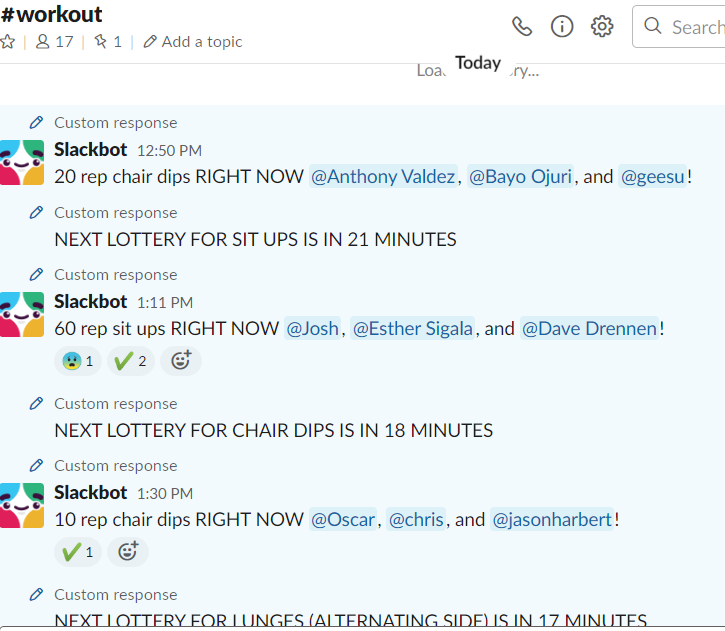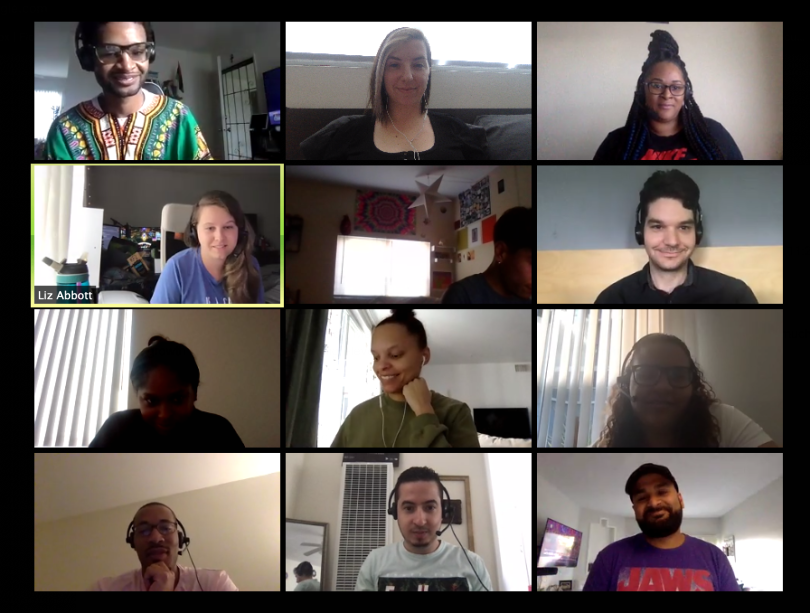Inside CareerArc’s open-floor office, there’s a section Linda Souza likes to call the Marketing Lounge. The area itself looks like something you’d see at any other startup office — it’s furnished with sit-stand desks, a TV and a table with chairs — but it’s what happens there that has taken on greater importance to Souza in recent times.
For Souza, who is the hiring software company’s VP of marketing, the lounge brings to mind daily gatherings large and small, where coworkers would collaborate on projects, celebrate engagements and birth announcements, and just hang out.
It’s that place and those little moments that Souza feared losing the most when the company moved to become a remote workforce to help stymie the spread of coronavirus on March 13. So, one of the first things she did was move it online, with an optional 15-minute Zoom calendar invite called “Virtual Water Cooler.”
“One of those things you really lose are those micro-moments that are not specific to a project you’re working on,” Souza said. “They are more about the camaraderie of being with people, and that’s one of those things that we’re missing with this whole coronavirus crisis.”
Souza and CareerArc aren’t alone in trying to replicate those moments. Whether other companies have a “marketing lounge” or not, every office has its own informal meeting places where employees can chat about everything from music to TV to ranking pets in tiers (is that just us?). On good days and on, well, Tuesdays, those spaces offer a necessary break from work and an opportunity to bond.
“Even if you were working from home already, you could go for dinner at a restaurant or to Starbucks, so you had those interactions. You don’t have that right now.”
As office-reliant companies across the country transitioned abruptly into a work-from-home setup to limit the spread of COVID-19, those natural connection points were severed. For many people, moving to remote work for the first time can be a difficult and isolating transition, which social distancing compounds, according to an American Psychology Association story.
Those interactions are more important now than ever, Souza said.
“You’re feeling that lack of socialization even more than in normal circumstances,” Souza said. “Even if you were working from home already, you could go for dinner at a restaurant or to Starbucks, so you had those interactions. You don’t have that right now.”
As a result, companies are turning to communication tools like Slack and Zoom to maintain those intraoffice bonds. We spoke with CareerArc, LA-based compliance management software company AuditBoard and warehouse logistics technology provider Flowspace about how their teams are staying connected.
Tips to Stay Connected While Working From Home
- Make time to gather virtually
- Moving around throughout the day helps boost physical and mental health
- Create unique Slack channels to help keep company culture alive
- Start a company-wide newsletter focused on personal and professional news throughout the week

Scheduling intentional video hangouts can bring coworkers closer together
Virtual hangouts can be a great way to bond, but sometimes there’s laundry piled up on the floor, clutter on the table in the background or a mess left behind from the kids that can make joining video chats an awkward experience. Enter the Zoom background feature.
At AuditBoard, people operations specialist Michelle Choe has turned selecting a background image for team meetings into an opportunity to bond. For each meeting, one team member is in charge of selecting a theme for that day’s virtual chat. One day it was “pick a place you’d like to be,” on another day it was “choose your favorite food.” (During our video chat, Choe selected the upscale living room from the movie Parasite, both out of love for the movie and her dream of living in a huge home one day).
The activity might seem small, but it’s been a quick and easy way for her team to simultaneously feel comfortable on the call and give people something else to talk about beyond work or COVID-19.
“We decided while we’re doing our daily activities, it’s a good way to get people excited about turning on their videos and really getting that interaction we all need and are used to getting from each other,” Choe said.
Beyond the backgrounds, team members also take turns coming up with a daily activity for each video call. They started week one introducing their pets and children to each other, held a dance party in which one team member aggregated everyone’s favorite songs into a playlist, and capped it off with a Friday happy hour where everyone wore their favorite headgear. (Michelle was torn between a beanie and her Mickey Mouse ears, which she never has reason to wear otherwise.)
“We’ve been able to bond on a more personal level because we are seeing each other’s animals and daughters, and even someone’s cat who she’s been talking about forever.”
Meanwhile, SVP of marketing John Reese made his team’s market launch party virtual.
“It’s going to be tough to mirror the experience you have with people in person, but I’m going to do my best to make sure it’s an a-typical Zoom call,” Reese said.
When it comes to video calls, it’s important to intentionally create time for spontaneous moments to pop up, Souza added. Since the tool is also used for team meetings and work talk, it can be easy to slip into work-only communications.
At CareerArc, Souza intentionally chose the name “Water Cooler” to signify that it would be a virtual space for employees to talk about anything other than work. She’s also made it optional, so no one feels obligated to join. So far, she said, it’s brought her team closer together.
“We’ve been able to bond on a more personal level because we are seeing each other’s animals and daughters, and even someone’s cat who she’s been talking about forever,” Souza said. “And he was just so cute.”
During the chats, they’ve learned about each other’s home improvement projects, secret talents and laughed over impromptu slice-of-life moments, like when one person’s husband walked across the screen with a bowl of cereal. The calls are only scheduled for 15 minutes, but they often go to 30 minutes, she said.
For extroverts, it’s an opportunity to connect; for introverts, it can be helpful just knowing it’s an option, Souza said. Ultimately, the water cooler provides a feeling of comfort during an unsettling time.
“For me, it does help feeling like there’s a sense of normalcy just in keeping us connected,” Souza said.
Virtual Connections
- Be intentional about hanging out. Scheduling optional meetings like virtual “water cooler” banter or happy hours can create a virtual space where people are more comfortable interacting on a personal level.
- Plan activities to do on the video call. Holding a dance party, virtual meditation or happy hour can help get people excited about interacting and turning on their cameras.
- Create Slack channels and challenges to encourage social communication. GIF battles, parenting channels and daily conversation topics have helped AuditBoard and Flowspace to bring people closer together across teams.
- Scheduling time to move around and exercise is important both for mental and physical health. It can be easy to spend a whole day on the couch. Flowspace created a fitness bot to keep employees moving together.
- Find ways to share positive stories as well as important information about COVID-19. Flowspace developed a weekly newsletter full of work from home tips, pet photos and helpful links to give employees a mental break from the daunting news cycle.

Finding ways to keep moving can keep people’s spirits up
When virtual logistics company Flowspace moved to a fully remote workforce on March 13, it also introduced a new fitness czar to the team in the form of a Slack bot.
The fitness program is completely optional, but those who sign up can expect to receive a random exercise to do every day. Starting early in the morning, the bot chooses three participants to complete a fitness challenge. The exercises can include leg lifts, lunges, squats and anything else that can be done at home without equipment, said Sarah Gardner, Flowspace’s head of people and culture.
“When you feel good and you’re moving around, it can just help your overall mood and happiness.”
The bot carries on a tradition of fitness-related benefits, including weekly boxing lessons and a gym stipend. It was important to Gardner that employees still find outlets to exercise or move around at home. It can be easy to never leave the couch and fall into a rut while working from home, Gardner said.
“When you feel good and you’re moving around, it can just help your overall mood and happiness,” Gardner said.
The fitness bot has also created an outlet for the team to feel connected throughout the day. They communicate with green checkmarks when they do a task, and some have bonded over the bot’s relentless demands for them to do squats.
Choe at AuditBoard has also been looking for ways to inspire employees to keep moving and stay mentally balanced. As her team entered its second week of social distancing, she planned to set up a weekly virtual meditation and exercise event — kids included.
“It’ll be good to get the energy out of their kids ... and it’ll be good for the whole AuditBoard community to come together and get some relaxing and fitness in too,” Choe said.
Creating special Slack channels for activities can unite people across teams
“If you had to describe Flowspace to an alien using only emojis, how would you do it?”
That Slack prompt kicked off a flurry of emoji combinations on Slack and a vote for the best ones. The prompt is part of a series of Slack challenges Gardner and her team are deploying to engage employees. Other planned Slack activities include a home tour called “Flowspace Cribs,” recipe exchanges and team trivia.
When it comes to work communication, Gardner doesn’t want employees relying on Slack more than necessary. If a conversation about a project would have been face-to-face, she encourages managers and employees to do it on a video call or Zoom. However, when used intentionally to bond, Slack can be a quick and easy way for employees to stay connected, she said.
“It’s really nice seeing people reaching out, and I do think Slack is a good way for people to interact and just remembering to check in on fellow extroverts.”
GIF battles and photo sharing has also been popular at AuditBoard. Choe created a new Slack channel called “Just for Fun,” where employees can go to find questions of the day and share personal tidbits. They’ve had people share photos of kids, their workstations and home plants. It’s created a natural forum for employees to connect across departments, she said.
“It’s really nice seeing people reaching out, and I do think Slack is a good way for people to interact and just remembering to check in on fellow extroverts,” Choe said.

Sending a newsletter can unify a message and connect coworkers
Still, it’s impossible to avoid the giant microorganism in the room. News about COVID-19 is everywhere, and often deeply unsettling.
In an effort to provide some mental-health support, Gardner said her team is distributing a weekly newsletter in the form of a PDF. The newsletter will contain tips and tricks on how to work from home, homeschooling advice, photos of dogs, positive news stories and a link to the Centers for Disease Control and Prevention.
“We want this to be a separate thing that people get, which takes them out of their day-to-day work and lets them take a break for a minute.”
While she could have done it as a regular email, the form changes the tone of the information.
“We want this to be a separate thing that people get, which takes them out of their day-to-day work and lets them take a break for a minute,” Gardner said. “It just connects them and gives them other things to talk about with their coworkers rather than just work.”
Whether it’s an email newsletter, a Slack channel or virtual happy hours, finding opportunities to bond are important. Moments of reprieve can make getting through this crisis a little more bearable.
“I think everybody kind of needs a reason to laugh right now,” Souza said.




